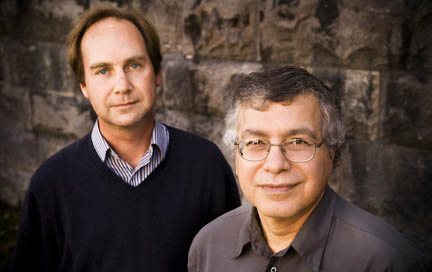Research and Discovery: Adding texture to Islamic texts
Research and Discovery: Adding texture to Islamic texts McGill University
User Tools (skip):
RESEARCH AND DISCOVERY
Adding texture to Islamic texts
Database will catalogue and contextualize Islamic works of science

Robert Wisnovsky and F. Jamil Ragep are building a unified database of Islamic teachings.
A new database that will serve the scholarly community in Islamic studies has received $363,127 in funding from the Canadian Foundation for Innovation (CFI), with matching funds from the Quebec Ministère de l'Éducation, du Loisir et du Sport, and additional funds from McGill's Faculty of Arts. Dr F. Jamil Ragep, Canada Research Chair in the History of Science in Islamic Societies, will lead the project with a total of $950,000.
For Dr Ragep, the need to catalogue and contextualize key Islamic texts is large and growing larger. "People have a lot to say about Islam, science, and philosophy, but it's based on a very, very small sampling of texts," he said. "We want the history and knowledge of the premodern period and traditions in Islam to be based on real, concrete information."
The hefty project title-"Scientific Traditions in Islamic Societies: Secularism and Rational Knowledge Structures as Integral to Premodern Islam" (STIS, for short)-reflects the ambition of the endeavor. The process of taking text embedded in mostly unread manuscripts from archives around the world and producing digital, readable, and searchable content is long and arduous. Questions such as ‘What is the role of Islam in terms of the development of science and philosophy?’ are monstrously complex, argues Ragep. “They must be broken down into components, and our database will enable you to do so.”
In the first project phase, images of over 5,000 of the 25,000 existing Islamic scientific manuscripts will be collected. The focus will begin with astronomy and expand to include fields such as mathematics, music theory, and optics.
Though ‘the words on each page' make up the core data, Ragep explained that the project's utility relies on an appreciation of more than text, author, title, and publication date.
"To get a sense of its place in Islamic society, our approach to the Islamic tradition includes where it began, where it went, and how it developed over time," says Ragep. To this end, the STIS database will weave together facts on who has studied which texts, where they were disseminated, and other sociological information-and every detail will be searchable.
The grant for STIS comes hot on the heels of another multi-funder grant to Dr Robert Wisnovsky, director of the Institute of Islamic Studies and research collaborator on STIS. Less than a year ago, Wisnovsky received $1,500,000 from CFI, the Quebec Ministère de l'Éducation, du Loisir et du Sport, and the Faculty of Arts to launch "The post-classical Islamic Philosophy Database Initiative" (PIPDI), a project that included Dr Ragep among its collaborators since its inception. The goal is to have a unified database with STIS because the cross-over benefits would be vast.
Questions such as ‘What is the role of Islam in terms of the development of science and philosophy?' are monstrously complex, argued Ragep. "They must be broken down into components, and our database will enable you to do so."
This allows for subtle sub-questions. "If astronomy texts were studied in religious schools, what does that mean? If a religious text contains discussions of Aristotle or Plato, what does that tell us?" ask Ragep. "These are questions that people living a generation ago would have been reluctant to address, but answers are possible with our methodology and the information we will collect."
For both Ragep and Wisnovsky, their commitment to the STIS and PIPDI projects are a mix of personal and professional.
"I had learned all the clichés about Islamic intellectual history in some very good schools in North America, and when I started doing research, the things I studied didn't jive very well," recounts Ragep. "I started in very technical matters of mathematics in Islam, but it became very difficult to explain things in the standard approach. I had to devise different ways of looking at these questions."
"My original ambition was to ensure that great Muslim thinkers are included in the heroic narrative of Western thought," says Wisnovsky. "I began to realize that Islamic philosophy, so voluminous and complex, was a vast cultural creation, not just a small number of geniuses or texts."

